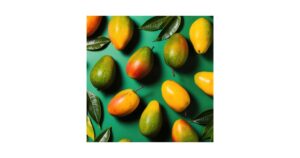CAN DOG EAT MANGO? Many dog owners are familiar with a puppy’s unique eyes that follow them around while they enjoy a tasty snack. Although it’s natural to want to share your favorite fruits with your furry friend, it’s important to make sure what you’re giving them is safe for them to consume. There is one such fruit that often raises questions among dog owners and that is mango. In this article, we’ll explore the potential benefits and risks of feeding mango to your canine companion.


Benefits of Mango for Dogs:
Mango is a tropical fruit that is rich in essential vitamins and minerals that can be beneficial to your dog’s health when given in moderation. Some of the potential benefits of feeding mango to your dog include:
Rich in Vitamins: Mangoes are a great source of vitamins A, C and E, which contribute to the health of your dog’s overall immune system.
Dietary Fiber: The fiber content in mangoes can aid digestion and promote a healthy gastrointestinal tract in dogs.
Antioxidants: Mangoes contain antioxidants that can help neutralize harmful free radicals while supporting your dog’s cellular health.
Natural Sugars: The natural sugars in mangoes can provide a quick energy boost for active dogs.
CAN DOG EAT MANGO?
Risks and Precautions:
While mango can be a healthy addition to your dog’s diet, it is important to be aware of the potential dangers and take precaution. Pit and peel: The pit and peel of the mango pose a choking hazard and can be challenging for dogs to digest. Always remove the pit and peel the mango before giving it to your dog. Moderation is key: Although mango offers nutritional benefits, it also contains natural sugars. Too much sugar in a dog’s diet can cause digestive disorders, including diarrhea. Feed mangoes to your dog in limited quantities. Allergies: Some dogs may be allergic to certain fruits, including mango. Introduce the mango slowly and observe your dog for any signs of allergic reactions, such as itching, swelling, or gastrointestinal problems. Consult your veterinarian: Before adding any new food to your dog’s diet, it is advisable to consult your veterinarian. They can provide personalized advice based on your dog’s health, age and dietary needs. conclusion: Ultimately, if offered responsibly, mango can be a delicious and nutritious food for your dog. By removing the kernels and skins, feeding in moderation, and monitoring for any adverse reactions, you can safely share this tropical delight with your furry friend. As always, consulting your veterinarian ensures that you make informed decisions about your dog’s diet, promoting a happy and healthy life for your canine companion.
Which nutrient is present in mango?
Mango is a rich source of various nutrients, providing a mix of essential vitamins, minerals and dietary fiber. Some of the major nutrients found in mango are as follows: Vitamin C: Mangoes are famous for their high vitamin C content. This antioxidant vitamin plays an important role in supporting the immune system, promoting healthy skin, and aiding iron absorption. Vitamin A: Mango is a good source of beta-carotene, a precursor to vitamin A. Vitamin A is important for maintaining healthy vision, promoting skin health, and supporting the immune system. Vitamin E: Mangoes contain vitamin E, which is an antioxidant that helps protect cells from damage. It also plays a role in keeping the skin and eyes healthy. Dietary fiber: Mango is rich in dietary fiber, which aids digestion and helps control bowel movements. Fiber is also beneficial for maintaining a healthy weight and supporting overall gastrointestinal health. Folate (Vitamin B9): Mangoes contain folate, a B-vitamin that is essential for cell division and the formation of DNA. Folate is especially important for aiding fetal development during pregnancy. Vitamin K: Mangoes provide small amounts of vitamin K, which is essential for blood clotting and bone health. Potassium: Mangoes contain potassium, an essential mineral that helps maintain proper fluid balance, support nerve and muscle function, and control blood pressure. Copper: Mangoes contain small amounts of copper, a mineral that contributes to the formation of red blood cells and supports the immune system. Quercetin and other antioxidants: Mangoes also contain various antioxidants, including quercetin, beta-carotene, and other polyphenols, which help neutralize harmful free radicals in the body.
I t is important to note that mango is a nutritious fruit, but it also contains natural sugars, so it should be fed to dogs in moderation. Additionally, as mentioned in a previous response, it is advisable to keep your dog
how to eat mango?
Eating mango can be a delicious and messy experience, but it’s worth it! Here’s a step-by-step guide on how to eat mango:


ripe mango cutting board; Knife. spoon Optional: paper towel or wet wipe for cleaning step: Choose ripe mango:
Choose a mango that is slightly soft to touch but not mushy. The peel should be red orange in color and a sweet aroma should come from near the stem. Wash the mangoes: Rinse the mangoes under cool, running water to remove any dirt or residue. Cut the ends: Place the mango on a cutting board and cut a small piece off from both ends to create a stable, flat surface. Find the seeds: Place the mango flat on a cutting board with one flat end facing up. The seed runs lengthwise through the middle of the fruit. You want to cut the mango at the seed edge. Cut Cheeks: Make two vertical cuts, one on each side of the seed, to obtain two large mango “cheeks.” Score the meat: Hold the mango pulp in your hand and make cuts lengthwise and crosswise in the pulp, taking care not to cut the peel. Break mango into pieces: Push the peel of the peeled mango from below and turn the mango pulp upside down, so that the mango pieces come out. Repeat with the other cheek. Eat mango pieces:
You can use a spoon to scoop out mango pieces or cut them directly. Eat leftover meat: If there is any remaining pulp around the seeds, you can cut it away or use your teeth to scrape off tasty bits. cleanliness: Mangoes can be juicy and sticky, so keep a paper towel or wet wipe nearby to clean your hands and face. Enjoy your delicious, juicy mangoes
how to peel mango?
- Mango can be a little difficult to peel due to its unique shape and slippery texture. Here’s a step-by-step guide on how to peel a mango: what you’ll need: ripe mango. cutting board Knife spoon Optional: peeler step: Choose ripe mango:
Choose a mango that is slightly soft to touch but not mushy. The peel should be red orange in color and a sweet aroma should come from near the stem. Wash the mangoes: Rinse the mangoes under cool, running water to remove any dirt or residue. Cut the ends: Place the mango on a cutting board and cut a small piece off from both ends to create a stable, flat surface. Find the seeds: Place the mango flat on a cutting board with one flat end facing up. The seed runs lengthwise through the middle of the fruit. You want to cut the mango at the seed edge. Cut Cheeks:
Make two vertical cuts, one on each side of the seed, to obtain two large mango “cheeks. “Score the meat:
If you prefer to peel the mangoes with a knife, you can score the cheek flesh of each mango with a crosshatch pattern. Be careful not to cut the skin. Use a spoon or peel: Once the pulp is cooked, you can use a spoon to remove the mango pieces by running a spoon between the peel and the pulp. Alternatively, if you have a peeler, you can peel the mango by carefully sliding the peel along with the pulp. Sort out leftover meat:
If there is any leftover flesh around the seeds, you can cut it off with a knife or use your teeth to scrape off tasty bits. Cleanliness: Mangoes can be juicy and sticky, so keep a paper towel or wet wipe nearby to clean your hands and cutting board. You now have peeled mango ready to enjoy or use in your favorite recipes!

